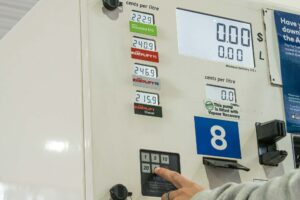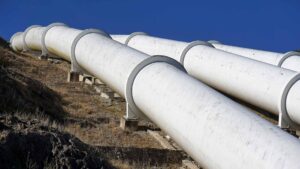There goes another year. And while it’s been a bit of a roller-coaster ride for local and global clean energy industries – with shifting government policies, unstable market conditions and some good old-fashioned nimby-ism helping to providing a few notable lows – there have been some high points along the way. Here – in no particular order – is our list of what helped provide the clean energy highlights for 2012.
1. Australia introduces a carbon price, the world doesn’t come to an end
Eleven days before Australia’s carbon pricing legislation came into effect on July 1 of this year, federal climate minister Greg Combet delivered a speech, touching on the reasoning behind the policy – “it will address one of the most pressing environmental problems (and) set the economy up for continued prosperity” – and on how it might change things for Australian people and businesses. He also listed some of the changes he did NOT expect to occur – most of them predicted by the leader of the Opposition, Tony Abbott – and so far he’s been pretty much spot on.
“Will there be ‘unimaginable’ increases in the cost of living, as Mr Abbott said?
Will the carbon price ratchet up household electricity prices by 30 per cent?
Will entire industries be destroyed? Mr Abbott said the carbon price spelt ‘death’ for coal, steel, motor vehicle manufacturing, zinc, nickel, and the food and grocery industries.
Will there be large-scale job losses? He said the carbon price would ‘wipe out jobs big time.’
And, finally, will Mr Abbott turn out to be right when he said that whole towns like Whyalla and Wollongong would be wiped off the map when the carbon price came in?”
In reality, the official introduction of the carbon price – “carbon Sunday” – came and went without incident and, as we wrote back in July, the Opposition changed its position accordingly, launching “a new advertising campaign that suggested Armegeddon would be drawn out like a TV mini-series, rather than a single, Biblical event.” But six months later, Abbott’s plot line is yet to develop – although his hard-fought scare campaign still seems to be paying off, with a November poll showing a “clear majority” of voters still opposed the carbon tax, despite agreeing that they were no worse off since its introduction. Popular or not, it appears to be doing its job.
2. The opening of Australia’s first utility-scale solar PV farm
Australia’s large-scale solar build might be lagging behind most of our international contemporaries, but the switching-on of the Greenough River solar farm – 50,000 PV panels in a paddock about 50km south-east of Geraldton – in October counts as a feather in our renewable energy cap. At just 10MW in size, the Verve Energy/First Solar collaboration might not be much to write home about, but as we wrote back in October, “it may presage a dramatic change in the way this country produces energy.”
3. Australia passes 2,000MW mark on household rooftops
Meanwhile, about eight million PV panels have been installed on Australian household rooftops, leveraging several billion in investment from households keen to have the opportunity to generate their own electricity, and do their bit to reduce emissions. It has, of course, been a hot topic, particularly around the way the feed-in tariffs and other incentives were constructed, and the way they were torn down. Whether you accept that “socket parity” – where households can generate electricity at a lower cost than sourcing it from the grid – is here or not, it is clearly an attractive proposition to many disaffected by rising network costs. And battery storage may offer an even more alluring proposition.
4. South Australia’s wind success story
“Nowhere in Australia has wind energy had as much of an impact on the existing electricity infrastructure as in South Australia.” So we wrote in October, when, according to the latest figures from the Australian Energy Market Operator, wind accounted for more than 22 per cent of capacity and 20 per cent of supply over the past year – although it has been higher over shorter periods – and at times supplied more than 80 per cent of the state’s energy needs.
In the March quarter of this year, for example, non-hydro renewables accounted for more than one third of the electricity generation in South Australia – 31 per cent of it from wind, with solar PV adding another 3.5 per cent. Compared to Australia’s total renewable generation, including hydro, at that time of just 9.4 per cent, this is certainly nothing to be sneezed at, but the most exciting part of the whole thing is that it helped push the price of wholesale electricity down considerably.
The headlines say it all…
5. Germany’s solar success story
It started back in February, when the Merkel government – under intense scrutiny at home and internationally for its ambitious renewables plan and nuclear phase-out – might have enjoyed a moment of solar schadenfreude, after exporting huge amounts of electricity to its nuclear neighbour France, whose power plants were struggling to meet demand during a freak cold snap.
This was the exact opposite scenario to that which had been predicted by those who opposed Germany’s power shift. As Zachary Shahan put it on CleanTechnica, everyone “got freaked out about how German electricity prices would rise and the country would just start importing electricity from France’s nuclear power plants.” But, he added, it “seems pretty clear that solar photovoltaics are bringing down the cost of electricity in Germany. Additionally, German electricity exports to France have been increasing!”
In June, German solar PV generated 22.4GW of peak capacity output within a week – the equivalent of 20 large nuclear or fossil fuel plants – accounting for around 30 per cent of the country’s capacity on the Friday, and half on the following Saturday, when a similar amount of energy was produced. In July – when the amount of solar capacity on the German electricity grid was set to overtake that of wind, making it the first major developed country in the world to boast more solar energy than wind – German solar power producers marked a new world record, having fed 14.7 TWh of sun-generated electricity into the national power grid during the first six months of 2012 – or 4.5 per cent of the total power production during that period. And in October, a European Energy Exchange report showed that both peak-load and baseload day-ahead electricity prices in Germany were lower than that of its nuclear-heavy neighbours, Switzerland and France.
6. Electric cars gear up
When the leader of the worldwide Catholic church starts getting around in an EV, you know something has shifted. The pope-mobile went electric in September this year with a new pair of Renault cars based on the Kangoo Maxi ZE, marking just one of the many small victories in a year that has largely been a success.
The release of the Tesla S – the company’s first full-size sedan, which in November became the first EV ever to win the Motor Trend Car of the Year: “We’re going to look back and see this as a point at which the gears of history really turned,” said Tesla CEO Elon Musk – provided another such boost; as did Canadian teen-pop idol Justin Bieber, who was gifted a newly released $100,000 luxury Fisker Karma for his 18th birthday, live on US midday television.
But a bigger, albeit less headline-grabbing, EV milestone came in May when Toyota’s 15-year-old hybrid plug-in EV, the Prius, cracked it as the world’s third best-selling car line in the first quarter of 2012. “Toyota sold a staggering 247,230 Prius hybrids, beating sales figures for cars like the Ford Fiesta, Chevrolet Cruze, Honda Civic and Volkswagen Golf,” reported Green Car Reports.
As the Union of Concerned scientists put it, 2012 has been the year of success by numbers for EVs, with automakers making large investments “that will bring dozens of new models on the market, growing competition and making EVs accessible for more drivers.” We would add that it has also been a year of appreciating EVs for their various off-road benefits, such as saving your life, or powering your home after a natural or nuclear disaster.
7. Carnegie Wave
It’s been a big year for this global award-nominated WA-based clean energy company, which in July signed an “historic” power purchase agreement (PPA) with the Australian Department of Defence for its 2MW demonstration plant that’s being built off Garden Island near Fremantle in Western Australia. As we wrote back then, “the PPA means that the HMAS Stirling naval base on Garden Island will buy all the energy from the installation, which will be Australia’s first commercial-scale grid connected wave energy facility.”
The deal also gave the company’s shares a boost, and provided a win for canny cleantech investor Mike Fitzpatrick (the former Carlton footballer and founder of Hastings Funds Management) and his co-investors, who snapped up a 10 per cent stake in Carnegie Wave from a distressed seller in the UK at just 1c per share – despite the prevailing share price of 3.5c – which by the close of trade had risen five-fold in value to 4.9c – or a total of $5.7 million from $1.14 million.
The plant will use the company’s CETO technology, the design for which it unveiled in September. Carnegie expects to begin construction of its Perth Wave Energy Project in the first quarter of 2013 and make its first power sales into the grid in the fourth quarter of 2013. The project recently attracted a $9.9 million grant from the federal government’s Emerging Renewables Program and a $5.5 million grant from the WA government, and the company is currently negotiating a power purchase agreement with local offtakers.
8. Hepburn Wind wins global industry gong
Australia’s first community-owned wind farm – the two-turbine, 4.1MW Hepburn Wind project at Leonards Hill, 10km south of Daylesford in Victoria – was this month recognised for excellence and awarded the World Wind Energy Award in Canberra. The wind farm – which, as Hepburn Wind chairman Simon Holmes à Court has pointed out, could not have been built under current Victorian planning laws – was initiated and partly funded by a 1900-member co-operative; most of its members being local to the project. Could this be the start of something big?
9. Tokelau becomes world’s first 100% solar-powered nation
The installation of a third and final solar PV mini-grid system was completed on the South Pacific archipelago of Tokelau in early November, giving the New Zealand-owned territory the capability to be the powered by 100 per cent solar energy. As we wrote back then, the Tokelau Renewable Energy Project – described as a “world first,” the largest off-grid solar power project in the world, and the largest solar system in the South Pacific – comprises 4,032 PV modules, 392 inverters and 1,344 batteries that will provide the entire electricity supply for the nation’s three tropical atolls – Atafu, Nukunonu and Fakaofo – replacing diesel generators. Coconut-oil fired generators will provide backup capacity for cloudy days. The New Zealand-funded project was overseen by Powersmart Solar and IT Power Australia. “Completed on time and on budget, the project is an excellent example of how small Pacific nations can lead the way on renewable energy development,” said NZ foreign affairs minister Murray McCully.
10. RenewEconomy founded
Last but not least, it’s been almost a year since Giles Parkinson launched this independent website, with the aim of discussing the ideas, analysing the trends, and examining the new technologies and the policies that will drive what has been described as the next industrial revolution – the global shift to a low-carbon economy. We think it’s going well! And did we mention we won an award…?











